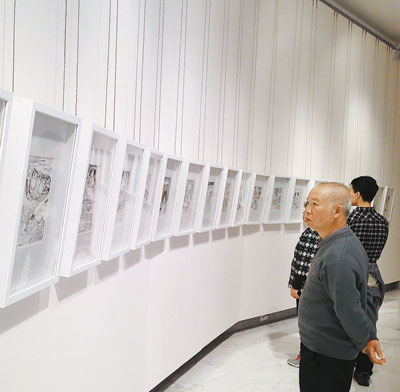|

Anna Zhao
anna.whizh@yahoo.com
MORE than 400 pieces of water and ink paintings are being exhibited at Guan Shanyue Art Museum in the eighth Shenzhen International Ink Art Biennial which will close Dec. 17.
Themed “The Youth’s Ink Stories,” the exhibited works are attributed to contemporary artists, most of whom were born in the 1970s and 1980s. While inheriting a strong heritage of traditional Chinese water and ink art, these artists have also made considerable breaks from tradition, which distinguishes them from their predecessors.
Organized by the Shenzhen Fine Art Institute, the exhibition is composed of two parts: forms of ink art: an overview of ink and brush, and prototype research.
Integrating modern
elements
Contemporary ink artists are not confined by the singular patterns created with brush and paper, but are widely utilizing modern media in their artistic expression.
A calligraphy work of four Chinese characters, “busheng bumie,” meaning the cycle of life, placed at the entrance of the museum’s main exhibition hall, may not appeal to visitors’ eyes at first glance. But it is actually a performance art piece created by the artist Hua Jun with glue and ashes. A video beside it displays how the work was produced with the author’s body movements and use of materials — the process of doing the work itself is meant to be portrayed as poetic.
“Thousand Moons” is a set of water-ink cartoons about moon stories simultaneously displayed on six TV screens. The animated pictures in water and ink, very different from the usual static presentations, bring the art a story-telling vividness.
The bold exploration of individuality and personalities by combining art with modern technology and materials is suggestive of the future development of ink art.
Dong Xiaoming and Yan Shanchun, curators of the exhibition, said that the artists have mastered great skills and maturity over traditional ink art by integrating various artistic expressions in their works, such as the use of light and shade, installation, oil painting, engraved painting and sculpture. A greater degree of interaction with contemporary art is pushing ancient ink art to a transition towards modernism.
Extending the
traditional base
Differing from older generations who mainly used stone rubbing and collage for artistic innovations, contemporary artists seek flexible expressions beyond just brush and ink.
They have more freedom in using materials and consider ink as a cultural carrier. They bestow their works with impressions of ink but without necessarily using it — while still keeping the essence of the tradition.
“Puppet” by Li Hongbo portrays two sculptures carved out of paper with their arms and legs stretched like vines.
Fu Xiaodong, curator of the prototype research, said that the new generation of artists do not discriminate between Oriental and Occidental traditions and see no cultural taboos nor national sentiment when they create works with water and ink.
Deviation from
tradition
The exhibition is dominated by subjects that are closely associated with traditional Chinese culture: the water and mountain scenery in traditional Chinese paintings, birds and flowers, religious figures and supernatural beings. However, many subjects are illustrated in unconventional ways.
“The Strange Stories of China” is a set of cartoons that interpret current social issues as supernatural stories. In these paintings, social ills or unconventional events are expressed through activities of creatures in eerie shapes or figures that only exist in legends, which offers a somewhat sarcastic overtone.
The rich contents and diversified patterns of expression in the exhibition indicate that contemporary ink art has gone well beyond its tradition and will further open up more artistic possibilities.
“Water and ink are not the only media for creating art, but are also representative of China’s cultural tradition and artistic values. Artists should continue to explore more visual effects from them,” Fu said.
Time: 10 a.m.-5 p.m., through Dec. 17 (closed Mondays)
Venue: Guan Shanyue Art Museum, Hongli Road, Futian District
Metro: Longhua Line, Children’s Palace Station (少年宫站), Exit C
|

